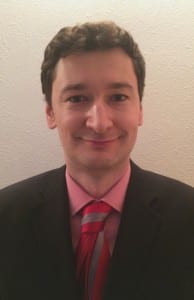
Assistant Professor Andrei Irimia
As the newest assistant professor at the USC Leonard Davis School of Gerontology, Andrei Irimia’s goal is to use the power of pictures—specifically, images acquired using cutting-edge neuroimaging techniques—to uncover how the anatomy and function of the brain changes as a person ages subsequent to experiencing brain injuries.
After studying computer science and mathematics and then earning a PhD in biophysics from Vanderbilt University in 2007, Irimia first came to California in 2008 as a postdoctoral scholar conducting research in the Multimodal Imaging Laboratory at the University of California, San Diego. In 2010, a second postdoctoral fellowship brought him to the Laboratory of Neuro Imaging at the University of California, Los Angeles before he first joined the USC faculty in 2013.
At UCLA, in collaboration with colleagues, he developed the connectogram, a uniquely visual approach to the mapping of the human connectome—the ways in which the neurons of the brain connect to one another.
“’A picture is worth a thousand words;’ that’s true in science as well,” Irimia says. “As a neuroimaging researcher, I’m interested in visualization tools, which can allow us to explore the very complicated architecture of the brain. [The connectogram] allows one to map the circuitry of the brain in a systematic fashion.”
Prior to his arrival at the USC Leonard Davis School this month, he was an assistant professor of research in what is now the USC Mark and Mary Stevens Neuroimaging and Informatics Institute. His current research focuses on the study of neurodegeneration in older adults caused by brain injury, including traumatic brain injury, intracerebral hemorrhage and stroke. Of particular interest to Irimia is how concussions affect the neurological and psychiatric health of older people.
“The goal of my research is to use neuroimaging to understand these effects and improve the quality of life of aging adults who are victims of brain injury,” he says.
Illustrating the seriousness of the issue, Irimia explains that a traumatic brain injury, or TBI, is most likely to result in death when it affects a person over the age of 65, with falls being the most common cause for TBI in older adults. Other research shows that insults to the brain can contribute to degeneration but affect individuals differently at different ages, with older people not able to recover as much as younger people, he adds. Compounding the issue is the risk of stroke, which primarily affects older people but which involves many of the same injury-related phenomena as TBI.
However, even TBIs experienced in early life have now been linked to increased risk of cognitive impairment in later life. In recent years, more attention has been paid to the emerging links between brain injury and Alzheimer’s disease and other dementias, Irimia says.
“There is tremendous need for further research in this area because it is a condition that has not been properly addressed,” he says. “Brain injuries are not only causing symptoms that last for weeks to months; problems are showing up years and even decades later. But right now, the immediate brain changes are not well understood because patients with minor injuries usually leave the hospital quickly.”
Irimia hopes that improving standards of care for brain injuries—as well as the fact that more people now know to go to the hospital for even a minor brain injury—will help to better address brain injury and prevent or lessen its aftereffects.
“Imaging techniques and connectomics could revolutionize and personalize brain treatment once we understand how age, sex, unique brain circuitry and genetics affect risk and which treatments will work,” he says. “Neuroimaging is well poised to uncover this information.”
Above: In collaboration with colleagues, Irimia developed the connectogram, a uniquely visual approach to the mapping of the human connectome—the ways in which the neurons of the brain connect to one another.





